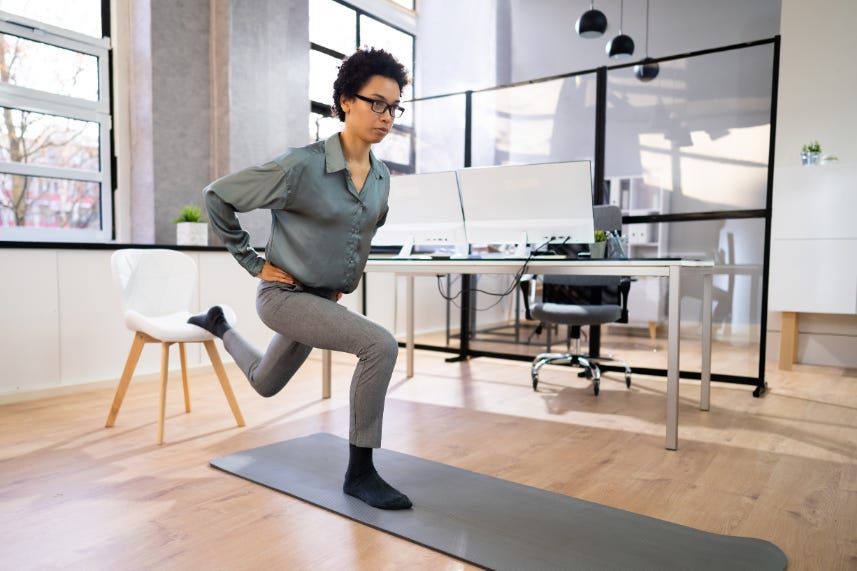Asymmetry Training for Muscle Health and Longevity
Complete with a plyometric bone health booster!
Human beings are asymmetric by design. This originates from our “handed-ness”, meaning being right-handed or left-handed. Whether we are right or left-handed is a reflection of which side of our body is our “dominant” side. Naturally, our dominant side is the stronger or most comfortable side we use to do various tasks.
In martial arts and interestingly, surgical training, managing natural asymmetry is important. Earlier in my career when I was training as a surgeon, my mentors would insist on learning to operate from both sides of the operating table. This is akin to learning to write with your right and left hands. Not easy! Similarly, a former martial arts instructor focused our training on establishing “strong” and “stronger” sides rather than surrendering to a “strong” and “weak” side.
Why on Earth is this important for mid-life women? Because training your asymmetries to build “strong” and “stronger” sides, creates strength, improves balance and stability (preventing falls and fractures) and promotes versatility in movements performed for any sport or physical task during our youth and as we age.
For more information on the benefits of asymmetric training, check out this recent post by my friend, Selene Yeager, in the Feisty 40+ Newsletter: Unilateral Lifts: Balance, Strength, and Longevity for 40+ Women
Today’s workout takes a page from the playbook of two very different former mentors, focusing on lower body asymmetry training with options for any level or mobility limitation.
Warm Up
AMRAP 7 minutes (As many rounds as possible in 7 minutes) - low to moderate intensity
20 single-under jump rope or simulated jump rope
10 easy push-ups (Use the elevated push-up to adjust the difficulty of the push-up - the higher the elevation, the easier the push-up).
TIP: Try to avoid doing push-ups from your knees. This releases much of the core engagement and core strengthening benefit of doing push-ups from your toes. By elevating the push-up, you can maintain core engagement while modifying the difficulty so that this movement is accessible to your level of fitness.
Movement Practice
Take 5-10 minutes to watch the video and test out various options for the single-leg squat. If none of these is an option for your abilities, check out the Movement alternatives below to find your best fit for this workout!
For the push-ups, select the option that allows you to achieve 5 unbroken repetitions confidently but not easily. This is a great opportunity to build strength in the push-up by making it challenging over a low-repetition range.
Workout
Today’s workout is taken from an excerpt from the CrossFit Gymnastics Training course and from the CrossFit workout library, Workout 230428.
AMRAP 20 (As many rounds as possible in 20 minutes)
5 strict push-ups (Use the elevated push-up option if strict push-ups are not accessible to you).
20 single-leg squats (total of 10 left and 10 right)
TIP: Depending on your option, you may choose to alternate legs each rep, or do small sets on one side before switching legs. Either way, ensure that you perform the same number of repetitions on both sides.
40 double-unders (or 80 single-unders or simulated jump rope)
So, why the push-ups? It’s a sneaky way to further challenge the core muscles needed for the single-leg squat while allowing the legs to rest!
Movement alternatives
Single-leg squat alternatives:
Bulgarian Split Squat (body weight or holding 2 dumbbells by your sides or a kettlebell as a “goblet” squat). If you choose this option, would recommend alternating legs every 5 or 10 repetitions.
Goblet Lunge (use a single dumbbell or kettlebell or body weight only) - do 5 or 10 repetitions before switching sides. TIP! Keep the front knee in line with the ankle - avoid tracking the knee over the toes
Walking or alternating lunge in place - body weight only, holding 2 dumbbells by your sides or holding a kettlebell in a “goblet” position at your chest.
If neither strict nor elevated push-ups are available to your, substitute a moderate to heavier dumbbell shoulder press.
Cool Down
Team! This is not one to skip! Your legs are a skeletal muscle powerhouse - and this workout challenged them to a high level. In turn, this requires high-level recovery and it begins with tissue care. Your legs will thank you!
20-minute “follow-along” lower-body foam roll and stretch
NOW TAKING NEW CLIENTS!
If you are an active woman or competitive midlife athlete who feels abandoned by mainstream medicine, I’m here for you!
It is with great excitement that after more than 2 years of preparation, I have FINALLY launched my Telehealth Consultation Medical practice focusing on the Reproductive Endocrine needs and Menopausal Care for active, athletic, and high-performing women.
Active and athletic midlife women have needs and risk profiles that are different from the general population. These needs often go unmet by the mainstream medical community due to a lack of understanding of fitness and sport and their impact on mid-life hormonal physiology or even a lack of acknowledgment that this dynamic exists. We put your health, fitness, and performance at the center of the equation so that you can achieve your healthiest, highest-performing self!
You will find all my service offerings on my website including a link to my calendar so that you can reserve your place in my schedule!




Thank you for sharing this. It takes just a few weeks of busy work or an injury to create imbalance from one side to the other. And then there's the risk of injury if we're compensating. In rock climbing if one side is much stronger the risk of ligament injury shoots up rapidly. These are great strategies I've started using to really focus on the movement before adding more weights.